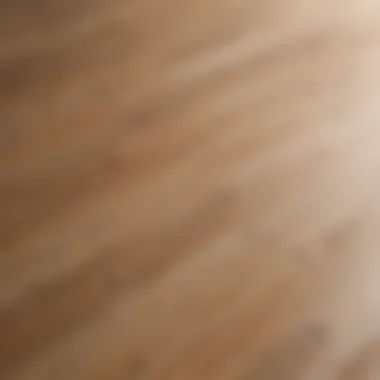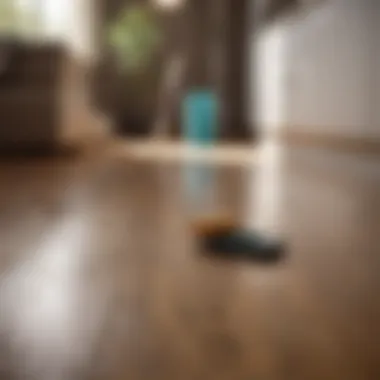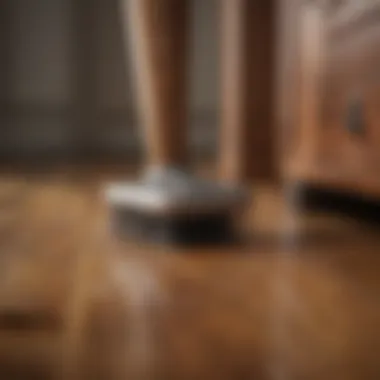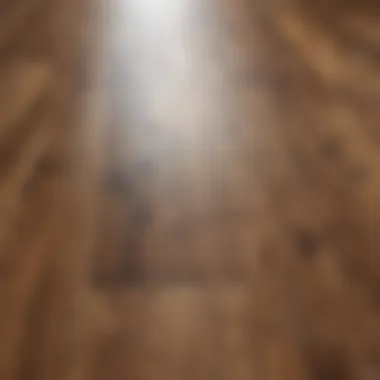Ultimate Soft Wood Floor Cleaning Guide


Intro
Cleaning soft wood floors presents unique challenges and opportunities. Soft wood, often more susceptible to damage and wear than its harder counterparts, requires appropriate care. Understanding its properties is crucial for homeowners and maintenance professionals alike. In this section, we will lay the groundwork for everything related to soft wood floor cleaning, from recognizing the material's unique characteristics to discussing suitable cleaning techniques and products. This guide aims to empower you with practical knowledge that enhances the beauty and extends the life of your floors.
Home Design Inspiration
Soft wood floors can complement various architectural styles and innovative decor trends, making them a favored choice for many homeowners.
Architectural Styles
Soft wood floors mesh well with a range of architectural designs. They provide a warm aesthetic that enhances both traditional and modern spaces.
- Cottage Style: This design often features soft woods, creating a cozy and inviting atmosphere. Soft wood floors fit perfectly into this theme.
- Contemporary: Minimalist spaces benefit from the natural tones of soft wood, which add character without overwhelming the space.
- Rustic: Exposed beams and unrefined finishes of rustic architecture harmonize with the natural looks of soft wood floors.
Innovative Decor Trends
As interior design evolves, innovative trends emerge. Among these trends, using natural elements plays a significant role in enhancing a space.
- Biophilic Design: Emphasizing the connection to nature, soft wood floors contribute to a calming, organic environment.
- Sustainable Materials: With increasing emphasis on sustainability, utilizing soft wood can be a responsible choice for consumers who value eco-friendly options.
"Natural materials, like soft wood, resonate with the ongoing push for sustainability in modern living, enhancing both aesthetics and responsibility."
These considerations set the stage for a deeper dive into the cleaning and maintenance of soft wood floors. By aligning your cleaning practices with your home's design, you can maintain a cohesive look that preserves the beauty and functionality of soft wood flooring.
In the next sections, we will explore cleaning techniques, suitable products, and maintenance strategies that are specifically tailored for soft wood floors. Understanding these fundamentals will help you care for your flooring effectively.
Intro to Soft Wood Floors
Understanding soft wood floors is essential for those looking to maintain their beauty and longevity. Unlike hardwood, soft wood floors are derived from trees that are less dense, making them distinct in both appearance and care requirements. Programmers, engineers, and design enthusiasts often focus on soft wood due to its aesthetic appeal, warmth, and versatility in various decor styles.
The primary benefits of soft wood flooring include its ability to provide a natural look that enhances interior environments. Moreover, they tend to be more flexible, which can add visual interest to a space. However, the softer texture also means they may be more prone to scratches and dents. Thus, effective maintenance and cleaning are paramount to preserve their integrity.
When considering soft wood floors, one must also take various factors into account. For instance, how much foot traffic the area experiences can dictate the level of care needed. Additionally, environmental factors such as humidity and sunlight exposure may impact the wood’s performance and appearance over time.
Ultimately, knowing the fundamentals of soft wood flooring sets the stage for understanding how to clean and maintain it effectively.
Characteristics of Soft Wood
Soft wood is derived from coniferous trees, which typically grow faster than hardwood trees. This characteristic contributes to the softer textures found in species like pine, fir, and cedar. Soft wood tends to feature prominent grain patterns and lighter hues, which can create a warm and inviting atmosphere in residential interiors.
The density of soft wood influences its resilience. Generally, it is less able to withstand heavy impacts compared to dens hardwood, making it imperative to adopt a more careful approach during cleaning. Its softer composition allows it to dent or scratch more easily, which means that using the right cleaning techniques and products is crucial for longevity.
Common Types of Soft Wood Flooring
Various types of soft wood flooring are available in the market, each presenting unique properties and aesthetic appeal. Popular options include:
- Pine: Known for its pale color and distinctive knots, pine flooring offers a rustic charm. It is often used in traditional settings.
- Fir: Fir flooring is similar to pine but tends to be slightly harder. It features a straight grain and light coloration, making it suitable for both modern and classic designs.
- Cedar: Cedar is aromatic and often used in outdoor applications. When used indoors, it provides a rich color and unique grain patterns that can make a statement.
- Spruce: With a fine grain and a light finish, spruce is used in many environments. It is versatile and works well in various home styles.
Understanding these types will facilitate informed decisions when selecting soft wood flooring, addressing both visual preferences and practical needs.


Understanding Soft Wood Flooring Maintenance
Maintaining soft wood floors demands a thoughtful approach. Unlike their harder counterparts, soft wood surfaces are more susceptible to scratching and denting. Proper maintenance not only extends the life of the flooring but also preserves its aesthetic appeal. Understanding the best practices for maintaining these floors is crucial for homeowners, interior designers, and real estate enthusiasts alike.
Importance of Regular Cleaning
Regular cleaning is indispensable for soft wood floors. Dust, dirt, and debris can accumulate easily, leading to scratches over time. These particles act like tiny abrasives, causing micro-damage with every step. By prioritizing a consistent cleaning routine, one can prevent this buildup and maintain the floor's finish.
Moreover, regular cleaning enhances the overall appearance. A clean, well-kept floor contributes to the ambiance of a room and adds value to the property. It is not merely an aesthetic concern; it is an investment in the home itself. Furthermore, regular maintenance can save costs over time by preventing more significant damage that might require expensive repairs or refinishing.
Visual Signs of Wear and Tear
Being vigilant about the visual signs of wear is paramount. Soft wood floors can show wear in subtle ways. Look for:
- Dullness in appearance: A floor that once gleamed can appear lifeless. If the shine diminishes, it may be time for a thorough clean or even a refinish.
- Scratches and dents: These can be minor at first, but they accumulate. Identifying these early can facilitate timely interventions, stopping minor issues from becoming major repairs.
- Discoloration: Areas that seem lighter or have lost color compared to surrounding sections could signal damage or the effect of sunlight.
- Uneven surfaces: This could indicate moisture issues or settling of the home.
Addressing these signs promptly can mitigate the need for future interventions and ensure the beauty of the soft wood flooring remains intact. Regularly monitoring the condition of the flooring not only keeps it in prime condition but also enhances its longevity.
Cleaning Products for Soft Wood Floors
When it comes to caring for soft wood floors, selecting appropriate cleaning products is crucial. Using the right solutions not only helps in maintaining the aesthetics of the wood but also enhances its durability. Many soft woods, such as pine or cedar, have specific characteristics that require tailored cleaning approaches. Thus, understanding cleaning products is essential to avoid potential damage.
Recommended Cleaning Solutions
Choosing the right cleaning solutions for soft wood floors can be daunting due to the wide range of products available. Here are some recommended solutions that are safe and effective:
- pH-Neutral Cleaners: These cleaners are specifically formulated to maintain the balance of the wood. They effectively remove dirt without stripping away the wood's natural oils.
- Vinegar and Water Mixture: A common and eco-friendly solution. Mix one part white vinegar with ten parts water. This solution can effectively clean minor stains and grime without harming the finish.
- Commercial Wood Floor Cleaners: Brands like Bona and Method offer cleaners that are made for soft wood floors. Always read the label to ensure compatibility with your specific flooring type.
- Soap-Based Solutions: Some mild, biodegradable soaps can also work wonders. Just ensure they are diluted properly to avoid excess residue.
It’s best to test any cleaning solution in a small, inconspicuous area first. This ensures compatibility and prevents any undesirable reactions that could damage the floor.
Avoiding Harmful Chemicals
The impact of harmful chemicals on soft wood floors cannot be overstated. Strong chemicals can lead to discoloration, surface degradation, and even long-term structural damage. Here are considerations to keep in mind:
- Avoid Ammonia-Based Products: These can strip away the finish and create problems with the wood's integrity.
- Stay Clear of Bleach: While effective in some cleaning contexts, bleach can discolor wood and weaken its structure over time.
- Check for VOCs: Products containing volatile organic compounds (VOCs) can be hazardous not only to the wood but also to indoor air quality. Look for low or no VOC options.
- Read Labels Carefully: Always examine product labels for information on contents and suitability for soft wood.
Incorporating safe cleaning products is not just about enhancing the appearance of wood floors. It is also about protecting the environment and ensuring a healthier living space.
Using the right cleaning products can extend the life of your soft wood floors, keeping them both beautiful and strong.
By being mindful of the cleaning solutions we use, we can preserve the beauty of soft wood floors while fostering a healthier home environment.
Cleaning Techniques for Soft Wood Floors
Understanding the cleaning techniques suitable for soft wood floors is vital for their upkeep. The unique characteristics of soft wood, such as its susceptibility to scratches, dents, and moisture damage, necessitate specialized cleaning methods. Utilizing appropriate cleaning techniques not only maintains the aesthetic appeal but also prolongs the lifespan of the flooring. By adopting these methods, homeowners can ensure their wood floors remain in excellent condition while achieving effective cleaning results.
Dry Cleaning Methods
Dry cleaning methods are essential for routine maintenance of soft wood floors. These techniques typically involve the use of brooms, microfiber dusters, or vacuum cleaners without water. They help in removing dirt and dust that can accumulate on the surface. Consider the following points when employing dry cleaning methods:
- Broom and Dustpan: Regular sweeping is simple yet effective. Use a soft-bristle broom to avoid scratching the wood.
- Microfiber Mops: These mops trap dust effectively and are gentle on wood surfaces.
- Vacuuming: Select a vacuum cleaner with a bare floor setting to prevent damage. Ensure it lacks a beater bar, which can scratch the finish.


Dry cleaning is crucial because it helps prevent debris from scratching the wood. Routine dry cleaning can significantly reduce the need for deeper cleaning, allowing floors to age gracefully.
Damp Cleaning Approaches
Damp cleaning is another integral technique for maintaining soft wood floors. This involves using a slightly damp mop or cloth to clean the surface without saturating it. Key aspects of damp cleaning include:
- Use of Appropriate Cleaners: It is essential to select cleaners specifically formulated for soft wood. Avoid products containing ammonia or strong detergents that can damage the finish.
- Humidity Management: Keep mops or cloths just damp enough to clean without pooling water.
- Spot Testing: Before applying any solution, test it in a small, inconspicuous area to ensure compatibility with your flooring.
Implementing damp cleaning can enhance the shine and remove tougher stains without causing harm to the wood. It’s an excellent method to maintain a spotless appearance while safeguarding the integrity of the flooring.
Avoiding Excess Moisture
Managing moisture is crucial to maintaining soft wood floors. Excess water can seep into seams, leading to warping, swelling, or other damages. To avoid excess moisture, consider the following suggestions:
- Immediate Wipe-Up: Any spills or moisture should be wiped up immediately to prevent absorption.
- Use Cloths Wisely: When damp-mopping, use a flat mop or cloth that does not retain excessive water.
- Control Humidity: In climates with high humidity, use dehumidifiers or air conditioning to regulate indoor moisture.
Avoiding excess moisture allows soft wood floors to retain their structural integrity and appearance for years. Regularly checking humidity levels can prevent potential future issues.
Proper cleaning techniques are essential to not only enhance the immediacy of visual cleanliness but also equip soft wood floors to withstand the test of time. Incorporating these practices into your cleaning routine will bolster the durability and appeal of your soft wood flooring.
Addressing Stains and Spots
Proper maintenance of soft wood floors involves recognizing and rectifying stains and spots as they occur. Addressing this topic is crucial for anyone who values the aesthetic and structural integrity of their flooring. Stains can not only detract from the visual appeal but can also lead to long-term damage if not treated properly. Therefore, understanding how to identify and clean these blemishes equips homeowners with the knowledge necessary for maintaining their soft wood floors effectively. This section delves into identifying different types of stains and offers practical spot cleaning techniques to manage them efficiently.
Identifying Different Types of Stains
To manage stains effectively, one must first identify their nature. Different sources lead to various types of stains, each requiring a unique approach for removal:
- Water Stains: Often caused by spills or high humidity, these may appear as dark or discolored spots. They may penetrate the wood but can usually be removed with proper techniques.
- Food or Beverage Stains: Liquid spills from drinks or food can create significant marks, especially fruit juices or coffee. They are often sticky and can attract more dirt.
- Oil Stains: Grease or oil spots, usually from cooking or similar activities, can be particularly challenging. They may require more intensive cleaning agents to eradicate completely.
- Ink Stains: Pen or marker ink can quickly discolor wood and needs immediate attention to avoid long-term damage.
- Animal Stains: Pet markings—often a combination of fur, dirt, and bodily fluids—present unique hurdles and need special consideration to clean effectively.
Spot Cleaning Techniques
Once stains are identified, one can implement appropriate spot cleaning techniques to address them effectively. Applying the right methods can ensure the longevity of the wood while restoring its visual appeal:
- Blot, Don’t Rub: For liquid stains, always blot the area gently with a clean cloth. Rubbing can worsen the situation by spreading the stain.
- Use Distilled Water: For many stains, especially water and food-related, using a slightly damp cloth with distilled water may lift the stains without causing additional marks.
- Mild Cleaning Solutions: For persistent blemishes, a mixture of vinegar and water can be effective. However, it is crucial to test this solution on an inconspicuous area first to ensure it does not damage the finish of the floor.
- Baking Soda Paste: Create a paste with baking soda and water to treat tougher stains like ink or oil. Apply it gently, let it sit for a few minutes, then wipe off with a damp cloth.
- Commercial Spot Cleaners: If home remedies do not work, consider using specialized wood floor cleaners designed for stains. Follow the manufacturer’s instructions carefully.
Important: Always prioritize testing any cleaning solution on a small, hidden area of your floor before applying it to the visible sections. This helps to prevent unexpected reactions.
Understanding how to address stains and spots will aid in preserving the allure and functionality of soft wood floors. By mastering the identification and cleaning techniques outlined above, readers can effectively maintain their floors, ensuring they remain beautiful and resilient over time.
Preventative Measures for Soft Wood Floors
Preventative measures play a critical role in maintaining the beauty and integrity of soft wood floors. By implementing simple but effective strategies, homeowners can significantly prolong the lifespan of their flooring while reducing the need for intensive cleaning or repairs. This section explores key preventative actions that ensure soft wood floors remain pristine and functional for years to come.
Using Floor Mats and Rugs
One of the most effective ways to protect soft wood floors is by strategically placing floor mats and rugs in high-traffic areas. These mats act as a barrier against dirt, dust, and moisture, which can cause scratches and damage. Particularly in entryways, placing durable mats allows for the collection of debris before it reaches the wood surface.
When selecting mats, look for options that are made from non-abrasive materials. These will not scratch the floor finish while still providing ample protection. Consider machine-washable rugs for ease of maintenance. Additionally, ensuring that mats are secured will prevent slipping, which helps avoid accidents that can lead to more wear on the floor.
Furniture Management


Proper management of furniture is essential in maintaining soft wood floors. The weight of furniture can cause dents or scratches if it is not managed carefully. Here are some recommendations:
- Use Furniture Pads: Applying felt pads under furniture legs can greatly reduce the risk of scratches. These pads create a cushion that protects the wood from direct contact with heavy objects.
- Avoid Dragging: When moving furniture, always lift rather than drag. This prevents excessive pressure on the floor surface, which can lead to damage over time.
- Strategic Placement: Position furniture in a way that distributes weight evenly. Avoid placing large items in the same area for extended periods. This minimizes wear from concentrated pressure.
By taking these preventative measures, homeowners can significantly enhance the durability of their soft wood floors. A few simple steps can lead to beautiful, long-lasting flooring. Investing time in prevention today will save time and money on repairs or refinishing in the future.
"An ounce of prevention is worth a pound of cure."
Ultimately, the investment in preventative strategies not only preserves the aesthetic appeal of soft wood floors but also contributes to a more comfortable and welcoming living environment.
Long-Term Care for Soft Wood Floors
Long-term care for soft wood floors is essential for maintaining their aesthetic appeal and structural integrity. The uniqueness of soft wood demands specially tailored maintenance practices. Applying a diligent care routine not only enhances longevity but also preserves the floor's natural beauty. By investing time and energy in long-term care, you can avoid costly repairs and replacements, which can be both disruptive and expensive.
Periodic Refinishing
Periodic refinishing is a crucial aspect of long-term care for soft wood floors. Over time, even the most diligent cleaning cannot prevent wear and tear. Refinishing restores the original luster of the wood and protects it from damage. The process involves sanding down the surface to remove any scratches or imperfections. After this, a new finish is applied to provide a protective layer.
The frequency of refinishing depends on several factors, including traffic levels and the type of finish used. Typically, every 3 to 5 years is recommended for homes with moderate foot traffic. A well-executed refinishing job can substantially enhance the floor’s durability. It is advisable to hire professionals for this job to ensure the best results.
- Benefits of periodic refinishing:
- Restores the floor’s appearance.
- Increases resistance to stains and scratches.
- Extends the life of the flooring.
"Refinishing is an investment in your home’s future. It elevates the character of your space while ensuring the floor stands up to daily challenges."
Professional Cleaning Services
Engaging professional cleaning services is another highly effective strategy for long-term care. Professionals have specialized equipment and expertise, which can make a significant difference in cleaning soft wood floors. They are familiar with various wood types and the appropriate techniques required to clean them safely.
Choosing a professional service can be particularly beneficial in situations where stubborn stains or deep-seated dirt is present. Experts utilize eco-friendly cleaning products specifically designed for soft wood, which helps maintain the integrity of the floor without causing harm.
- Key considerations when hiring professional cleaners:
- Check for experience with soft wood floors.
- Inquire about the cleaning methods and products used.
- Read reviews and ask for references from previous clients.
Maintaining soft wood floors through both periodic refinishing and professional cleaning services can ensure their beauty and functionality for years to come. Proper long-term care is not an expense; it is an investment.
Epilogue
In wrapping up this comprehensive guide, it is clear that proper cleaning and maintenance of soft wood floors are crucial for maintaining their beauty and longevity. Soft wood, with its unique properties, requires a thoughtful approach to ensure it withstands daily wear. The importance of cleaning cannot be overstated, as regular care prevents damage and enhances aesthetic appeal.
Summarizing Key Points
To recap the major points discussed:
- Understanding the nature of soft wood is essential for appropriate care.
- Selection of cleaning products is critical. Using suitable solutions and avoiding harsh chemicals can help maintain the wood's finish.
- Different cleaning techniques, ranging from dry methods to damp approaches, should be employed based on the specific cleaning need.
- Addressing stains promptly can prevent lasting damage. Knowing how to identify each stain type allows for more effective treatment.
- Preventative measures like using rugs and managing furniture can reduce wear on soft wood floors.
- Long-term care, including periodic refinishing and considering professional services, ensures the wood stays in top shape.
This summary highlights how these various practices collectively extend the life of soft wood flooring.
Emphasizing the Value of Maintenance
Consistent maintenance is not just about looking good; it is about the integrity of the floor. Attention to soft wood floors protects them from damage. Regular cleaning routines, swift stain removal, and preventative practices are all vital. Adopting these methods leads to several benefits:
- Effective regular maintenance prevents costly repairs down the line.
- A clean floor enhances the overall ambiance of any space, showcasing the natural beauty of the wood.
- Investing time in care reflects on property value, an aspect crucial for real estate enthusiasts and interior design aficionados alike.
Ultimately, soft wood floors can be a magnificent feature of a home. However, they necessitate respect through thoughtful care and maintenance. Embracing these practices will yield advantages that are significant both aesthetically and functionally.







